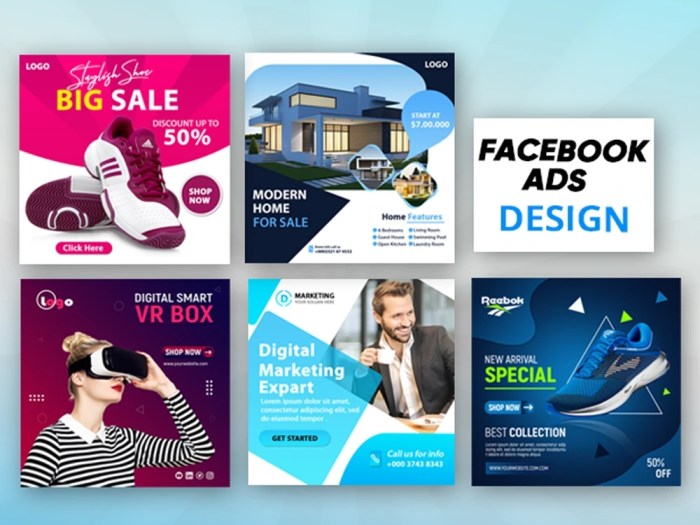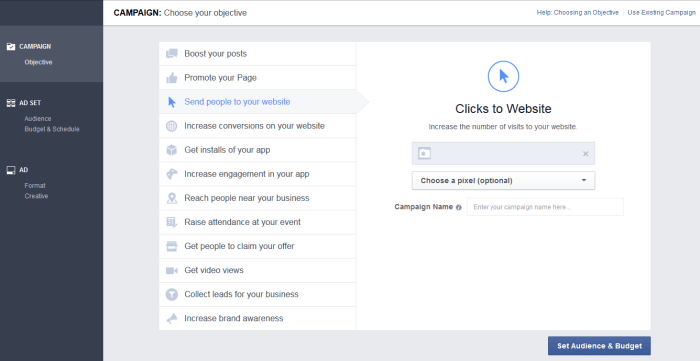Unlocking the power of Facebook advertising requires a strategic approach. This guide delves into the essential elements of crafting high-converting Facebook ad campaigns, focusing on three crucial steps: understanding your audience and objectives, creating compelling ad creatives and copy, and optimizing campaigns for maximum impact. Learn how to leverage data-driven insights and creative strategies to achieve your marketing goals.
We’ll explore effective targeting strategies, compelling ad copywriting techniques, and data-driven optimization methods. By mastering these three core areas, you’ll be well-equipped to design Facebook ad campaigns that not only capture attention but also drive significant results, boosting conversions and achieving your business objectives. Prepare to transform your Facebook advertising strategy from ordinary to extraordinary.
Understanding Your Target Audience and Defining Objectives

Effective Facebook ad campaigns hinge on a deep understanding of your target audience and clearly defined objectives. Without this foundational knowledge, your advertising efforts will lack focus and likely underperform. This section will guide you through the process of identifying your ideal customer and setting measurable goals for your campaign.
Target Audience Persona: A Detailed Example
Let’s imagine we’re launching a new line of organic, vegan protein bars. Our target audience would be health-conscious millennials and Gen Z individuals (ages 25-40) residing in urban areas of major US cities like New York, Los Angeles, and Chicago. They are likely environmentally aware, active on social media (particularly Instagram and Facebook), and interested in fitness, healthy eating, and sustainable living. They are likely to follow fitness influencers, health and wellness blogs, and pages dedicated to vegan recipes and lifestyles. A typical persona might be Sarah, a 32-year-old yoga instructor living in Brooklyn, who is actively seeking high-protein snacks that align with her vegan lifestyle and busy schedule. She’s digitally savvy and values authenticity and transparency in brands.
Facebook Ad Campaign Objectives and Key Performance Indicators (KPIs)
Defining clear objectives is crucial for measuring campaign success. Here are three distinct objectives and their corresponding KPIs:
- Brand Awareness: The goal is to increase brand visibility and recognition among the target audience. KPIs include reach, impressions, and website visits (to check for brand exploration).
- Lead Generation: The objective is to capture contact information (email addresses, phone numbers) from potential customers interested in the product. KPIs include lead form submissions, cost per lead (CPL), and conversion rate.
- Website Traffic: The aim is to drive traffic to the company website to encourage product purchases or further engagement. KPIs include website clicks, click-through rate (CTR), and cost per click (CPC).
Facebook Ad Formats and Target Audience Effectiveness
Different ad formats cater to varying needs and audience preferences.
- Image Ads: Simple, visually appealing images are great for showcasing the product and delivering a clear message. They are cost-effective and easily digestible but may lack the engagement of video.
- Video Ads: Videos are highly engaging and allow for storytelling, showcasing product benefits, and building brand connection. They can be more expensive to produce but offer higher potential for engagement and conversions.
- Carousel Ads: These ads allow for showcasing multiple images or videos in a single ad unit, providing more information and options for users to explore. They are particularly effective for highlighting product features or different product variations. They are more complex to create than image ads but allow more information to be delivered.
For our vegan protein bar campaign, a combination of video ads (showing the protein bar being enjoyed in various active lifestyles) and carousel ads (highlighting different flavors and ingredients) might be most effective in reaching our target audience.
A/B Testing for Campaign Optimization
A/B testing is essential for optimizing campaign performance. By testing different ad creatives (images, videos, text), targeting options (demographics, interests), and ad copy, you can identify the most effective elements and refine your strategy over time. For instance, we could A/B test different images of the protein bar (one showcasing a close-up of the texture, another showing someone enjoying it after a workout), different ad copy focusing on different benefits (taste vs. nutritional value), and different targeting parameters (focus on fitness enthusiasts vs. vegan communities). Analyzing the results will reveal which variations yield the highest conversion rates and ROI.
Crafting Compelling Ad Creatives and Copy

Creating effective Facebook ads requires more than just a great product; it demands visually appealing creatives and persuasive copy that resonates with your target audience. This section will explore how to craft compelling ad creatives and copy that drive conversions. We’ll delve into different design approaches, copywriting structures, and persuasive techniques to maximize your ad’s impact.
Facebook Ad Creative Examples
Effective Facebook ad creatives should be visually engaging and immediately communicate the value proposition of your product or service. They should also align seamlessly with the accompanying ad copy. Below are three examples demonstrating different creative approaches.
- Creative 1: Problem/Solution Focus – This ad features a before-and-after image showcasing a person struggling with a messy home before using a cleaning service (before image: cluttered living room, stressed individual), and then a pristine, organized home after using the service (after image: sparkling clean living room, relaxed individual). The visuals are bright and clean, focusing on the transformation. The color palette is calming and evokes a sense of peace and order.
- Creative 2: Benefit-Driven Approach – This ad uses a vibrant, high-quality image of a person happily using a new fitness tracker. The image is dynamic, showing the person actively engaged in their workout. The colors are energetic and positive, reflecting the feeling of accomplishment and well-being. The focus is on the positive emotions and results associated with using the fitness tracker.
- Creative 3: Storytelling Approach – This ad uses a series of three images that tell a short story. The first image shows a person struggling with a difficult task (e.g., complicated paperwork). The second image shows them using a software solution to streamline the task. The third image depicts the person successfully completing the task with a sense of relief and accomplishment. The visuals are professional and relatable, highlighting the emotional journey.
Compelling Ad Copy Structures and Techniques
The structure of your ad copy significantly impacts its effectiveness. Different approaches resonate better with various audiences. Below are examples illustrating three common structures:
- Problem/Solution: “Tired of endless paperwork? Our software streamlines your workflow, saving you time and reducing stress. Try it free today!” This directly addresses a pain point and offers a clear solution.
- Benefit-Driven: “Achieve your fitness goals faster with our new fitness tracker. Track your progress, stay motivated, and unlock your full potential. Order yours now!” This focuses on the positive outcomes of using the product.
- Storytelling: “Sarah was overwhelmed by her to-do list until she discovered our productivity app. Now, she’s organized, efficient, and stress-free. Join Sarah and transform your productivity. Download the app today!” This uses a relatable narrative to connect with the audience on an emotional level.
Persuasive Language and Emotional Appeals
Persuasive language and emotional appeals are crucial for creating compelling ad copy. They enhance engagement and encourage conversions.
- Persuasive Language Examples: Using power words like “revolutionary,” “transformative,” and “unbeatable” can create a sense of urgency and excitement. Quantifiable results (“Save 50% on your energy bill!”) add credibility and attract attention.
- Emotional Appeals Examples: Appealing to emotions like happiness (“Experience the joy of a clutter-free home!”), security (“Protect your family with our advanced security system.”), or belonging (“Join our community of fitness enthusiasts!”) creates a stronger connection with the audience and makes the ad more memorable.
Optimizing Campaigns for High Conversion Rates

Successfully launching a Facebook ad campaign is only half the battle. True success lies in continuous optimization to maximize your return on investment (ROI). This involves closely monitoring key metrics, strategically adjusting bidding strategies, and proactively responding to performance data. By implementing these strategies, you can significantly improve your conversion rates and achieve your campaign objectives.
Key Metrics Beyond Standard KPIs
Tracking standard KPIs like impressions and clicks is crucial, but focusing solely on these can be limiting. To gain a deeper understanding of campaign effectiveness and pinpoint areas for improvement, three additional key metrics should be monitored: Website Conversion Rate, Cost Per Conversion, and Average Order Value. Website Conversion Rate shows the percentage of website visitors who complete a desired action (e.g., purchase, sign-up). Cost Per Conversion reveals the cost incurred for each conversion, offering insights into campaign efficiency. Finally, Average Order Value indicates the average revenue generated per conversion, highlighting opportunities to upsell or cross-sell. Analyzing these metrics in conjunction with standard KPIs provides a more comprehensive view of campaign performance, guiding more effective optimization strategies. For example, a high cost per conversion alongside a low average order value might suggest a need to refine targeting or improve the ad creative to attract higher-value customers.
Optimizing Bidding Strategies for Maximum Conversions
Facebook offers various bidding strategies, each suited to different campaign goals. For maximizing conversion rates, the most effective approach is typically cost-per-conversion (CPC) bidding. This strategy automatically optimizes bids to achieve the lowest cost per conversion, focusing Facebook’s algorithm on delivering ads to users most likely to convert. However, cost-per-thousand-impressions (CPM) bidding can be strategically useful in the initial stages of a campaign to build brand awareness and reach a wider audience before shifting to CPC bidding for conversions. A hybrid approach, starting with CPM to build reach and then switching to CPC to optimize for conversions, can be particularly effective. Careful monitoring of performance metrics is crucial to determine the optimal bidding strategy and adjust as needed. For instance, if CPC is consistently high, revisiting targeting parameters or ad creatives may be necessary.
Continuous Monitoring and Adjustment of Ad Campaigns
A dynamic approach to campaign management is crucial for sustained success. Regular monitoring and adjustment based on performance data are essential. A weekly review of key metrics is recommended. If conversions are significantly below targets, analyze the data to identify the root cause. This might involve testing different ad creatives, refining targeting parameters, or adjusting the bidding strategy. For example, if a particular ad set underperforms, consider pausing it and reallocating budget to higher-performing sets. Conversely, if a campaign is exceeding expectations, consider increasing the budget to capitalize on the positive momentum. A proactive approach to monitoring and adjustment ensures campaigns remain effective and efficient, maximizing ROI.
Comparison of Facebook Ad Targeting Options
| Targeting Option | Advantages | Disadvantages | Example Use Case |
|---|---|---|---|
| Interest-Based Targeting | Wide reach, relatively inexpensive | Less precise targeting, potential for irrelevant impressions | Reaching users interested in “sustainable fashion” for an eco-friendly clothing brand. |
| Lookalike Audiences | Targets users similar to existing customers, high conversion potential | Requires a sufficient seed audience, potential for overlap with other targeting options | Targeting users similar to existing email subscribers for an online retailer. |
| Custom Audiences | Highly targeted, high conversion potential | Limited reach, requires existing customer data | Retargeting website visitors who added items to their cart but didn’t purchase. |
Conclusive Thoughts

Designing successful Facebook ads involves a holistic approach encompassing audience understanding, creative excellence, and data-driven optimization. By strategically defining your target audience, crafting compelling ad creatives and copy, and continuously monitoring and adjusting your campaigns based on performance data, you can significantly improve your conversion rates and achieve your marketing objectives. Remember, consistent A/B testing and a commitment to data-driven decision-making are key to sustained success in the ever-evolving landscape of Facebook advertising.